Known for its rich cultural heritage, Vietnam is also a land of traditional crafts, where techniques and ancestral know-how testify to a unique sensitivity.
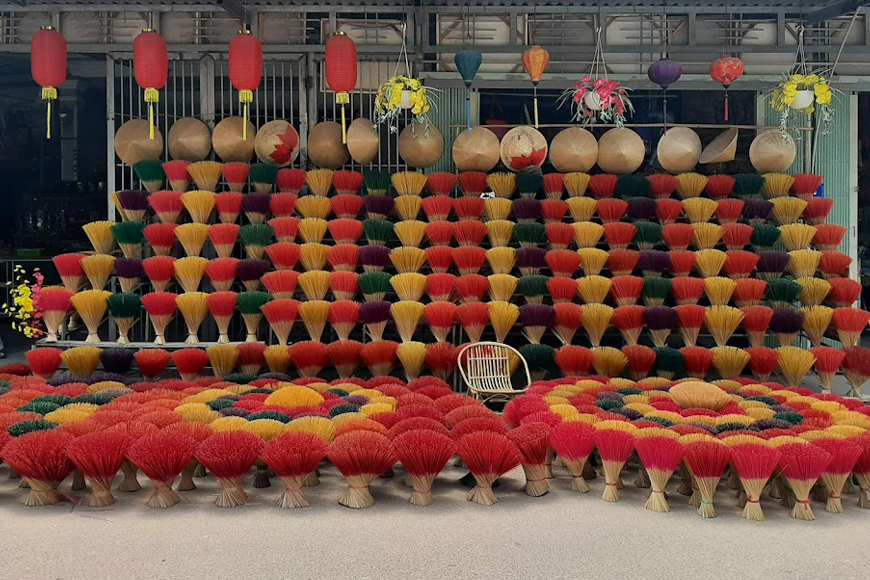
Encens ward in Hue city (Thuy Xuan) - Photo : Internet
Traditional crafts in Vietnam, a very long history
It is safe to say that Vietnam’s handicrafts date back to the very beginning of civilization, when people started making tools and objects out of stone, bone, shells and wood. Over time, they have developed techniques for working with metal, ceramics, textiles, paper, bamboo, rattan, lacquer, etc.. You can get a good overview by visiting the Ethnography Museum of Hanoi.
The end of the Chinese conquest – during the 15th century – coincided with the displacement of the capital of Hoa Lu to Thang Long (present-day Hanoi), which led to the birth of craft villages around and on the banks of the Red River. Mainly dedicated to the crafts of luxury and sacred, these villages provided the Royal Court with silks, ceramic jewelry and other embroidery, as well as they delivered temples and pagodas in objects of worship. Some even exported to China and Japan. A visit to the Temple of Literature in Hanoi gives a vision of these remarkable skills. The work of the fabric was also very present with in particular many villages specializing in silk weaving.
Alongside this craft, a slew of corporations produced popular pieces for everyday use, from agricultural tools to ceramics found in kitchens, to cotton, silk and other rattan baskets. Today remains the famous and bustling Quater of 36 streets and corporations, in old Hanoi. It was not until the 17th century that this district was organized into streets and alleys dedicated to a particular craft, where each artisan from his village offered his know-how but also a little of his roots. Trade with the capital was going well, markets were created, a whole ecosystem developed over the years. And it is not the move of the capital to Hue that will stop business, the «36 streets» taking advantage of the Chinese populations who came to Vietnam to trade.
Marked by cultural and commercial exchanges with neighboring countries, including China, India, Cambodia, Laos, Thailand, as well as contacts with Westerners, including the French, Portuguese, Dutch, the English, traditional crafts in Vietnam has also adapted to the vagaries of history with its wars and socio-economic transformations.
Despite the increasing urbanization, the all-round construction of industrial areas with foreign or urban capital and land speculation, Vietnam tries to keep the originality of its crafts by maintaining its craft villages that continue to integrate industrial and craft activities into the rural economy.
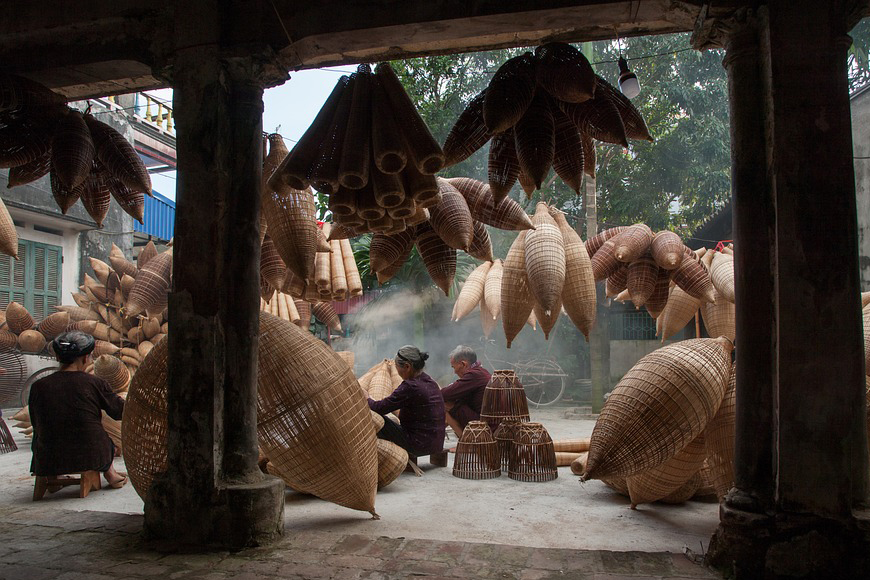
Traditional Craft Village - Photo : Pixabay
Features of traditional crafts in Vietnam
Traditional Vietnamese craftsmanship is distinguished by its rich diversity and strong regional identity. Each region, province or village has its own artisanal products that reflect the natural resources, needs, tastes and traditions of the population and/or ethnic community. For example, northern Vietnam is famous for its ceramics, lacquer, silk, paper, bronze, wood, bamboo and rattan, among other products. Central Vietnam is well known for its work of porcelain, embroidery, lace, leather, marble, coral, etc. As for the South of the country of the two Deltas, it is famous for basketry, weaving, pottery, mother-of-pearl, ivory, silver and gold, to talk only about those
Traditional Vietnamese craftsmanship is also distinguished by its finesse, beauty, durability and sustainable use.
Emblems of traditional crafts in Vietnam
There are many traditional handicrafts in Vietnam that reflect the richness and diversity of this sector. Here are some of the best known and most appreciated:
Pottery and ceramics
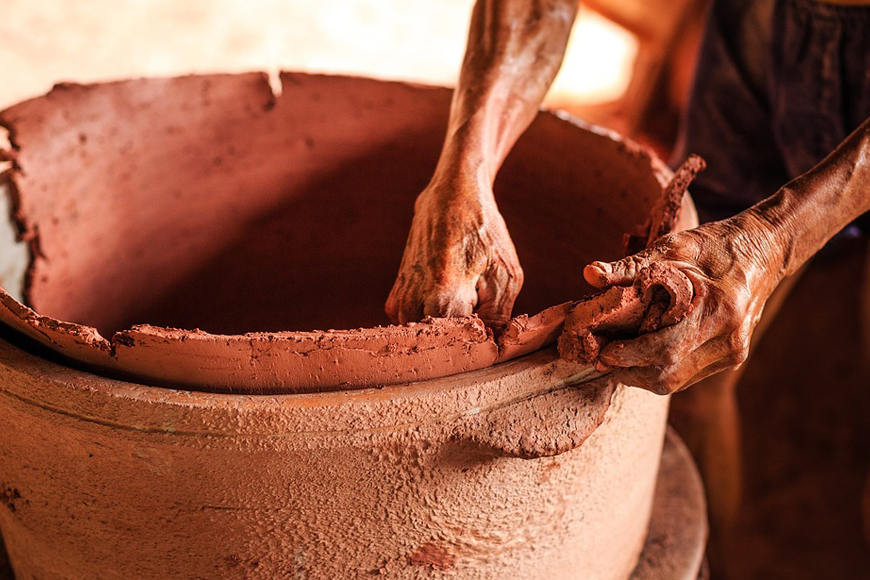
Pottery Traditional Craft - Photo : Pixabay
Throughout history, several villages have specialized in the manufacture of pottery and ceramics; we will mention in particular those of Bat Trang, Phu Lang and Kim Lan, which offer museums, guided tours and workshops for a total immersion in the discovery of this millenary craft. Alternatively, we will visit the villages of Tho Ha, Chu Dau, or Bien Hoa.
Each village has its own characteristics in terms of style, color, pattern and quality. Vietnamese ceramics are used for crockery, decoration, ritual objects, etc. It is appreciated for its finesse, solidity, diversity and originality.
For the record, in 2010, to celebrate the millennium of Hanoi, we produced the longest mosaic in the world: extending over 4 kilometers from the An Duong gate to the Van Kiep gate, its many paintings tell the history and heritage of Vietnam.
The lacquers
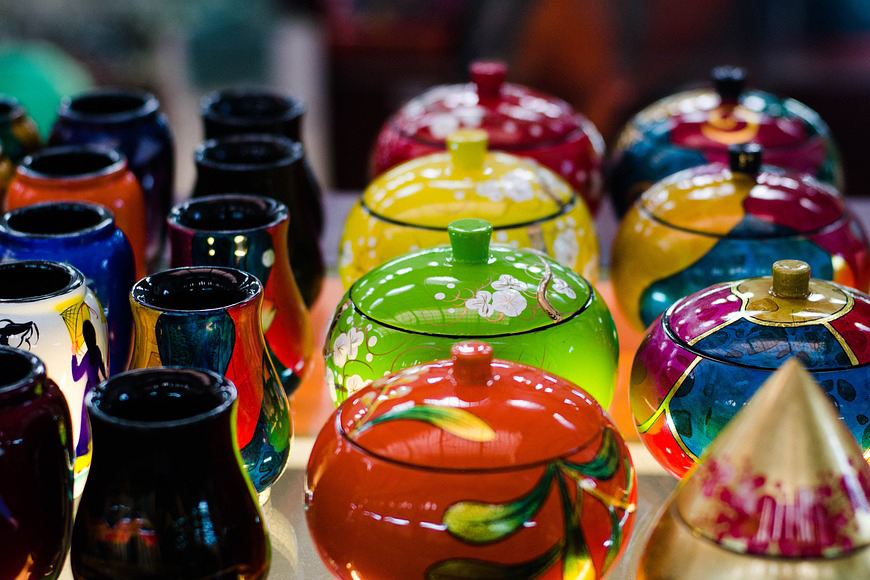
Lacquers Traditional Craft - Photo : Pixabay
Although coming from China, this traditional craft typical of Vietnam consists of applying several layers of plant resin on a wooden, bamboo, metal or paper support, then sanding, polishing and decorating them with mother-of-pearl inlays, gold, silver, egg, etc. Vietnamese lacquer is used to make paintings, trays, boxes, vases, furniture, etc. It is especially appreciated for its brilliance, depth, richness and complexity. We will mention here the most famous village in this craft, Ha Thai, today located in the suburbs of Hanoi.
Silk
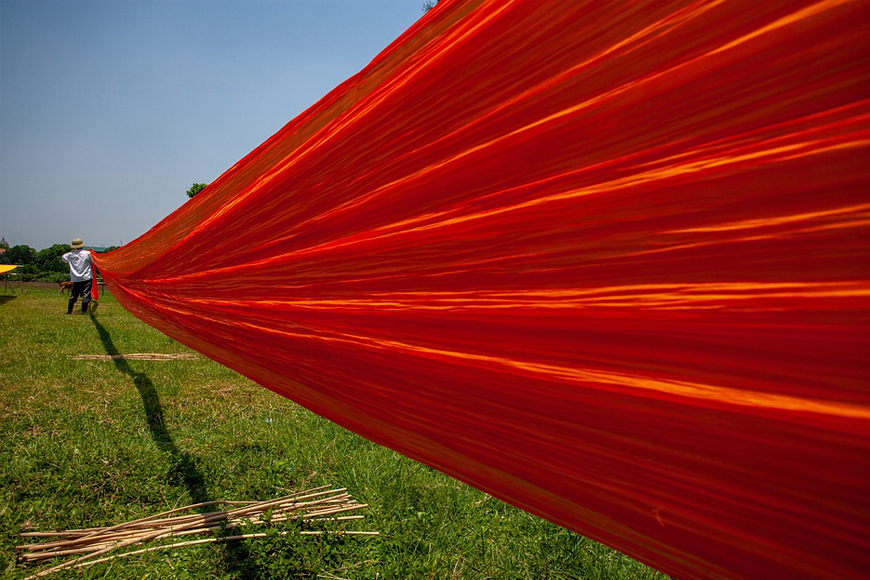
Silk Traditional Craft - Photo : Pixabay
It is said that the technique of silk weaving dates back to 3,000 years before Christ in China. It is a luxury product, with its dedicated villages, one of the most famous is Van Phuc and its Ha Dong silk, sought for its finesse, softness, lightness and beauty. Vietnamese silk is used to make clothes, sashes, scarves, cushions, curtains, etc. It is appreciated for its variety, quality, durability and elegance.
Basketry, with the work of bamboo and rattan
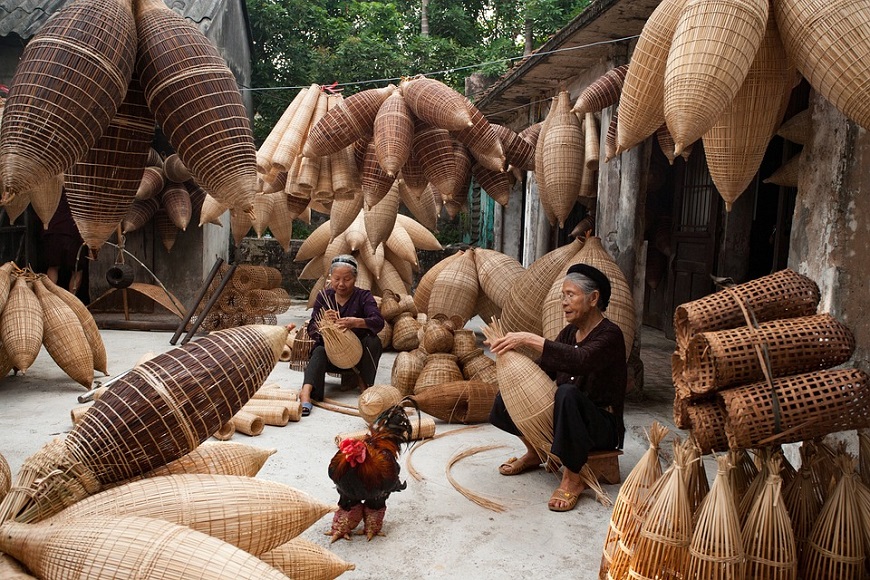
Basketry Traditional Craft - Photo : Pixabay
A widespread craft in Vietnam, basketry consists of weaving plant fibers, such as bamboo, rattan, rush, palm, coconut, etc. to make baskets, hats, mats, fans, lamps, furniture, etc. It is appreciated for its simplicity, solidity, functionality and charm. If the rustic charm of bamboo and rattan touches you, then it is the village of Phu Vinh, about thirty kilometers from Hanoi that you must visit.
Embroidery
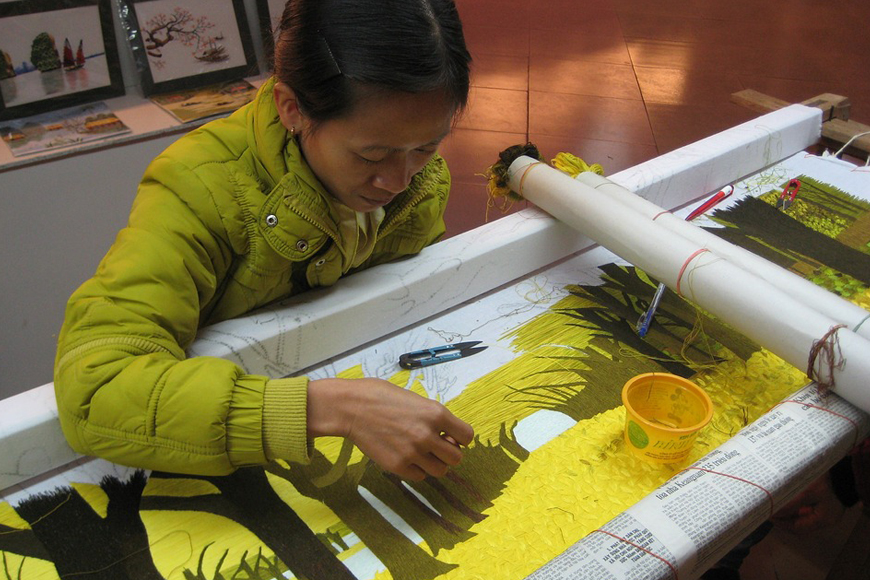
Weaving Traditional Craft - Photo : Pixabay
Traditional decorative art of Vietnam, embroidery – as everyone knows – consists of adorning fabrics with threads of silk, cotton, wool, etc. In Dragon Country, embroidery is used in the manufacture of paintings, tablecloths, napkins, blankets, cushions and other clothing. We appreciate its finesse, delicacy, diversity and creativity. To be convinced, leave Hanoi, travel 25 km to the village of Quat Dong, well known for its colorful hand embroidered products reflecting the soul and creativity of an entire people.
The paper and the prints
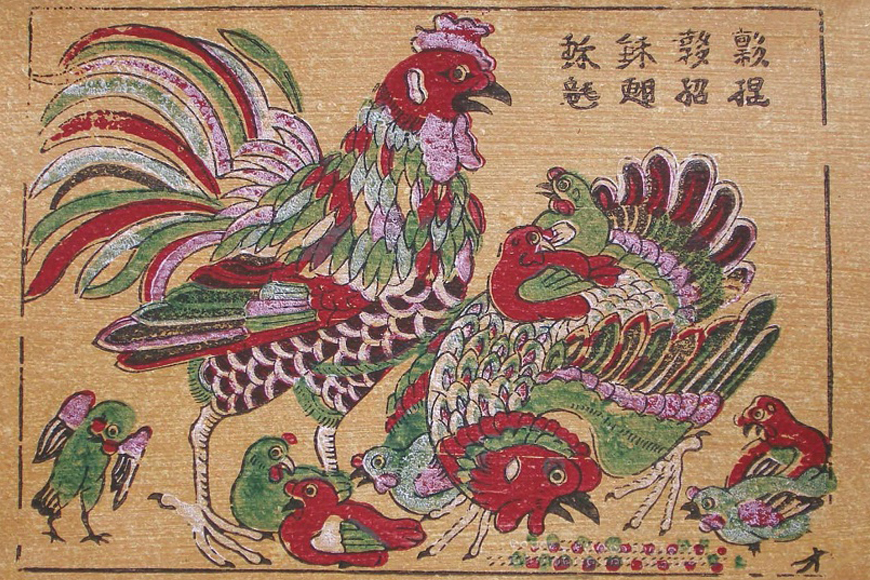
Traditional Dong Ho paintings - Photo : Travel Vietnam
Let’s finish our discovery of traditional crafts in Vietnam with paper work and the art of printmaking. Both have a special place in the heart of the Vietnamese in that they are a part of the memory of the country. The prints are made from traditional vegetable paper "do". White shell powder is then applied to the surface, making it shiny. The colors, of natural origin, are then used to dye the leaves. Dong Ho village in Bac Ninh Province is famous throughout the country for its prints.
Very popular for the Lunar New Year, the prints of Dong Ho have as themes life in the countryside, agricultural work, traditional festivals…
Tradition from China, burning paper objects is a way of transmitting wishes to deceased relatives. And in fact, many objects are made of paper in Vietnam, from toys and puppets to cult objects that are burned on the Ancestors altar or in pagodas (it is necessary to send offerings to the geniuses so that the ancestors can be happy). The place to discover these ephemeral ritual objects is Hang Ma Street, in the Old Quarter of Hanoi.
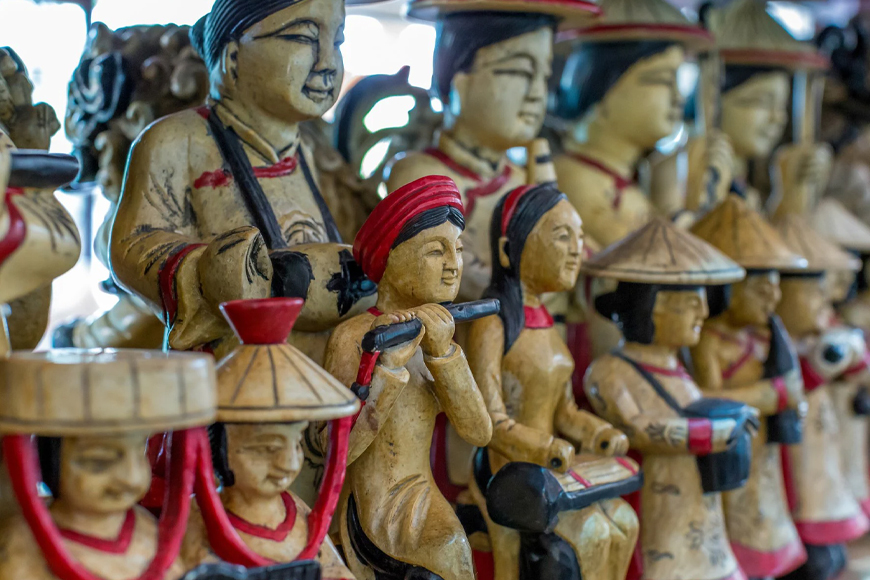
Souvenirs in Ceramic - Photo : Internet
The current situation of traditional crafts in Vietnam
In the current context of globalization, traditional crafts in Vietnam must face many challenges but also know how to seize new opportunities.
On the one hand, it must face competition from industrial products, loss of markets, reduction of natural resources, environmental degradation, standardization of products, loss of know-how, etc. On the other hand, it benefits from the support of authorities, organizations, associations, but also tourists, who recognize its cultural, economic, social and environmental value.
Thus, the implementation of initiatives to preserve, promote and develop traditional crafts in Vietnam allows and facilitates the training of artisans, the creation of cooperatives, product diversification, quality improvement, but also the promotion of fair trade, the valuation of responsible tourism… which helps to make traditional crafts in Vietnam a colorful and vibrant sector, reflecting the identity, wealth and beauty of the Country with Palanches.
Cultural and economic heritage that must be preserved and valued, while adapting it to the needs and tastes of the current market, it is the witness of the diversity and creativity of the Vietnamese, who have taken advantage of their environment and history to create unique and original products. While also representing a means to strengthen social and community ties, to transmit knowledge and values, to promote sustainable and equitable development.